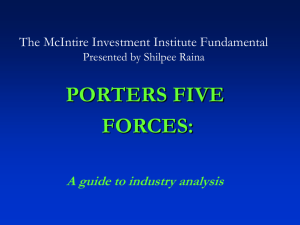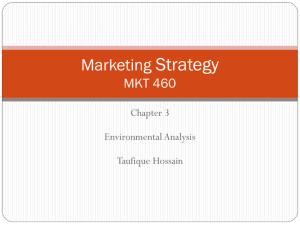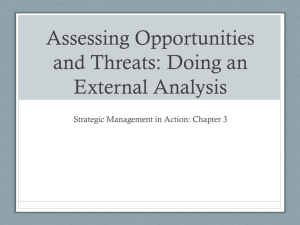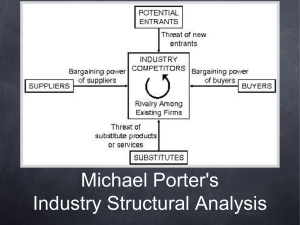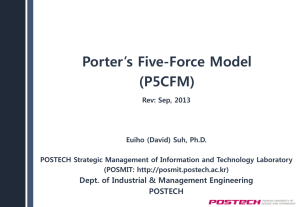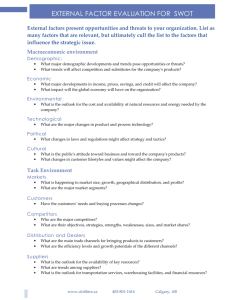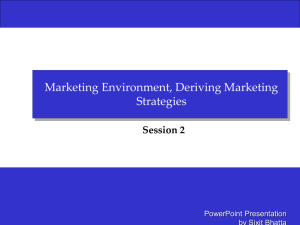Strategic Management in Action
advertisement
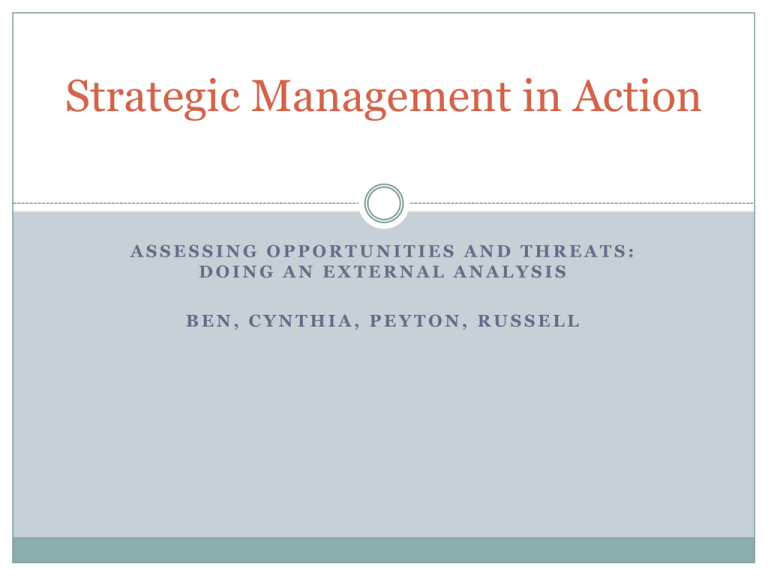
Strategic Management in Action ASSESSING OPPORTUNITIES AND THREATS: DOING AN EXTERNAL ANALYSIS BEN, CYNTHIA, PEYTON, RUSSELL Introduction This chapter illustrates why strategic decision makers must pay attention to and monitor changes in the external environment. #1-Describe what external analysis is #2-Identify positive and negative aspects of the environment #3-Why doing external analysis is important and why managers at all levels need to analyze the environment Case #1 External factors can significantly affect companies’ strategic decisions and actions: Movie theatre attendance was down Find ways to make the movie going experience special Variable pricing All-digital approach On-line ticket sales Alcoholic beverages Babysitting Valet parking Simulcasts of sporting events and concerts Describe What an External Analysis Is: External analysis-The process of scanning and evaluating an organization’s external environment How managers determine opportunities and threats facing their organization Opportunities-positive external trends Will improve and organization’s performance Threats-Negative external trends Will hinder an organization’s performance This is important to know so that new strategies can be formulated to respond to the opportunities and threats of the environment Environment Open systems-organizations that interact and respond with their environment Environmental uncertainty-the amount of change and complexity in an organization’s environment The more complex/dynamic the environment, the more information decision makers need about the environment to make appropriate decisions They then do an external analysis and the environment becomes a source of information Environment Environment is viewed as a scarce and necessary resources that are sought by competing organizations It is important for strategic decision makers to engage in environmental scanning How to do an External Analysis External environmental sectors Specific environment= customers, competitors, suppliers, and other industry-competitive variables General environment= economic, demographic, sociocultural, political-legal, and technological factors Analyzing involves looking at industry and competitive variables A strategic decision maker can determine the opportunities and threats in the specific environment by evaluating the five forces Potential Entrants, Substitutes, Bargaining power of buyers, and Suppliers Current Rivalry Among Existing Firms Rivalry exists between organizations to gain customers and profit. Strategic Groups: Group of firms competing with similar strategies, resources, and customers. Example from class about the automotive industry. 8 Conditions of Intense Rivalries Porter has 8 ways to determine if the rivalry is intense: 1. Numerous or equally balanced competitors: In an industry with many companies, people believe they can do things without being noticed. Balanced competition leads to jockeying for position. 2. Slow industry growth: When industry growth slows, the “market pie” is not getting any larger, thus for companies to grow they must steal the market share from others. 3. High fixed or storage costs: Companies want to spread out their fixed costs. This leads to price cutting which leads to intense competition. If the storage costs are high, the companies will want to sell their products quickly. 4. Lack of differentiation or switching costs: When there is no differentiation, consumers make their decision based on price. Example: Restaurants and copiers. 8 Conditions of Intense Rivalries cont. 5. Addition of capacity in large increments: Organizations that want to avoid overcapacity spur intense rivalries by cutting prices in order to distribute products. Example: Royal Caribbean cruise ships 6. Diverse competitors: When competitors differ in strategy and philosophies their actions are unknown, which intensifies the rivalry. 7. High strategic stakes: With a lot of money and time invested company leaders will do whatever it takes, such as sacrificing short-term profitability. Example: Wal-Mart 8. High exit barriers: Exit barriers= “economic, strategic, and emotional factors that keep companies competing in businesses”. These barriers make companies feel “stuck” in an industry and might use extreme tactics Example: specialized assets that cannot be liquidated, and pride. Potential Entrants and Barriers to Entry Organizations have to be concerned with the opportunities and threats (OT of SWOT analysis), but also pay attention to new entrants. The threat of new entrants depends on the barriers to entry. Barriers to entry : obstacles to entering an industry. If barriers to entry are high, then the threat to entry is low, which is good for the industry. 7 Major Entry Barriers 1. Economies of scale: The new organization may not be able to afford to purchase high volume, thus cannot use economies of scale. 2. Cost disadvantages from other than scale: Established competitors enjoy protected technology, favorable access to raw materials, favorable location, government subsidies, knowledge and experience. Example: Hollywood studios digital film standards. 3. Product differentiation: Current competitors have spent years to establish unique products and have substantial brand loyalty connections with consumers. 4. Capital requirements: Significant financial resources are necessary in some industries which can shut people out of consideration. Example: Ski Resorts 7 Major Entry Barriers cont. 5. Switching costs: Switching costs are the costs facing a customer who switches from one product to another. This includes money, and time of searching. Example: Word processing packages. 6. Access to distribution channels: The current competitors may have already secured the logical distribution sources. The company may have to give the distributor a price break, thus decreasing profits. 7. Government policy: Laws and regulations can be imposed (licensing, pollution standards, etc.) that may cost a large sum of money to adhere to. Bargaining Power of Buyers The customer is more important to the seller than the seller is to the customer because the customer can go elsewhere to purchase its products. Buyers can play competitors against each other to find the best price. Wal-Mart example Buyers have power if the product is standard and undifferentiated because they face low switching costs. Buyer gets the power if they have the ability to manufacture the products they need. Also, the buyer has power if the seller’s item is not important to the quality of the buyer’s product. Buyers have bargaining power if they have full information about demand, market prices and supplier costs. The internet has made this possible. Example: Car and electronic sales. Bargaining Power of Suppliers If suppliers have bargaining power they can raise prices or reduce the number of services provided. Suppliers can reduce the quality of products your industry purchases. Industry suppliers include any resource providers: raw material sources, equipment manufacturers, financial institutions, and labor sources. What makes suppliers powerful? If suppliers are few in number and are selling to an industry that’s fragmented. If buyers are small and not very powerful, then suppliers can influence prices, quality, and sales terms. Often there are no substitutes for the products the suppliers provide. Substitute Products Companies must look to see if other industries can satisfy consumer needs. If there are many substitutes in your industry, even not so great ones, it can be very unfavorable for your industry. General Environment Economic- includes macroeconomic data such as: current statistics, forecast trends, and changes in the economy. Interest rates, exchange rates, and the value of the dollar are major parts of economic data. Other aspects of economic include GDP, GNP, deficits and surpluses, consumer income and spending habits. Demographic Evaluates trends in population characteristics. Includes information that the U.S. census bureau gathers such as age, gender, income levels, ethnic makeup, education, geographic location, birthrates, and employment status. U.S. population is currently around 305.6 million. There are more Americans over the age of 30 than under, and Americans are slowly becoming more educated. Sociocultural Knowing what is going on with your customer culturally. Knowing what a country’s culture likes and how is the culture changing. What are the traditions, values, beliefs, tastes, behaviors, and how are they changing Look at values and attitudes to determine what is happening in the sociocultural sector. Political Legal Sector where Laws, regulations, judicial decisions, and politics at state and government levels are analyzed. Some examples include: Occupational safety and health Act of 1970 Consumer product safety Act of 1972 Civil rights Act of 1991 North American Free trade Agreement of 1993 Political-Legal Sector Involves various laws, regulations, judicial decisions, and political forces at the federal, state, and local levels of government that have an impact on an organization. Equal Employment Opportunity Act of 1972 Americans with Disabilities Act of 1990 Consumer Product Safety Act of 1972 Sarbanes-Oxley Act of 2002 Political-Legal Sector Cont. Other major political-legal concerns include taxation, minimum wage, and product labeling/product safety laws, all of which can have a significant impact on an organization’s financial performance. If an organization does business in other countries, the relevant laws and regulations must be obeyed. Multinational corporations and IFRS Technological Sector Scientific or technological innovations that create opportunities and threats. X-Static and the Environmental Protection Agency Computerization is one of the most important technological innovations and continues to affect both organizational work processes and product development. Many variables determine whether a given technology will prove to be an opportunity or a threat to an organization Global locations Finding and Evaluating Information on the External Environment When looking for external information look for Data Predictions Statistics Forecasts Analysis Inferences Trends Statements Cont. External information can be found using informal and unscientific observations or by using a more formal, systematic search. Informal – talking to customers and suppliers’ sales representatives, reading industry trade journals and general news magazines. Formal – using an external information system An information system that provides managers with needed external information on a regular basis. Responsibilities In smaller and medium sized organizations, external analysis needs to be done by all employees, especially those on the front lines. In larger organizations, external analysis is usually the responsibility of managers. Benefits & Challenges of an External Analysis Benefits Makes managers proactive Provides information used in planning, decision making, and formulating strategy Helps organizations get needed resources Helps organizations cope with uncertain environments Makes a difference in an organization’s performance Challenges Rapidly changing environments can be hard to keep up with Time consuming Forecasts and trend analysis aren’t perfect Takeaways #1-A strategic decision maker can determine the opportunities and threats in the specific environment by evaluating the five forces: Potential Entrants, Substitutes, Bargaining power of buyers, and Suppliers #2-Determining if a rivalry is intense or not is an important decision. An intense rivalry is a sign of a red ocean industry Takeaways cont. #3-How can you tell whether an industry's supplier is powerful? One thing to look for is domination by a few companies and more concentration than the industry. If your industry is just one of many that the supplier sells to than you won't be a priority to the supplier, and they will exhort bargaining power over you. #4-It is important to find information on the external environment and evaluate it to formulate future strategies. #5-When looking for external information, look for data, statistics, trends, etc. made by experts.

